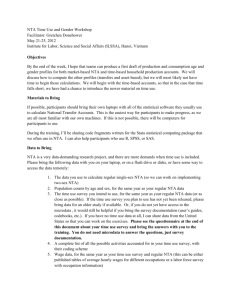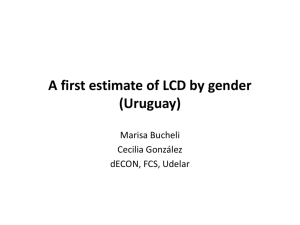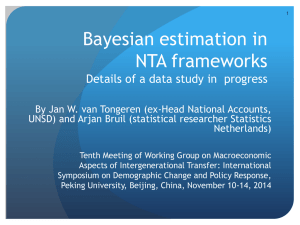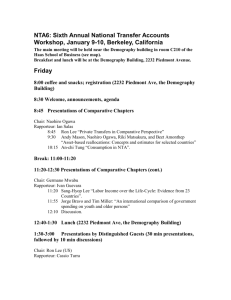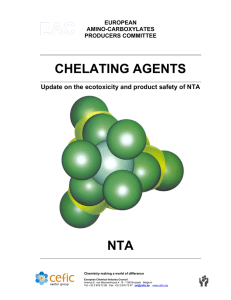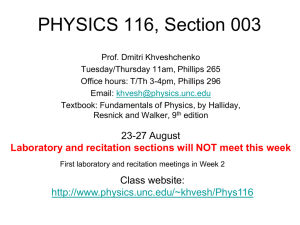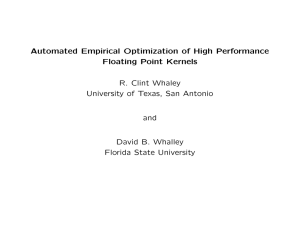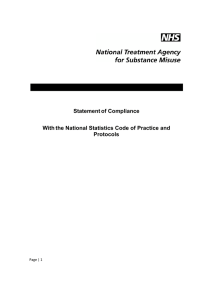Annual Quality Management Systems Review
advertisement
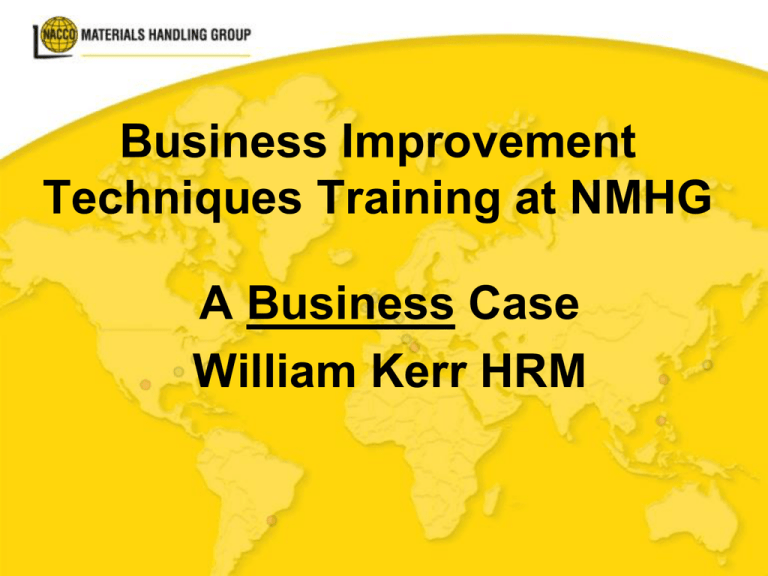
Business Improvement Techniques Training at NMHG A Business Case William Kerr HRM Contents • NMHG – The Company • The actual, no messing about, very scary, Business Scenario late 2008-early 2009! • The Plan, why Training? • The Delivery • The Outcomes • Thought for Today • Some additional slides about HRM, RoI, Benefits of NTA & DMAIC, which you will probably not read but really ought to! Overview of NACCO • NACCO Industries, Inc. is an operating holding company with subsidiaries in the following principal industries: lift trucks, small appliances, specialty retail and mining. • In 2010, total revenues were $2.7 billion and net income was $79.5 million. NMHG Organisation • NMHG designs, engineers, manufactures and sells Materials handling equipment under the Hyster® and Yale® brand names. • Lift trucks and component parts are manufactured in 10 countries worldwide including, the United States, Northern Ireland, Scotland, the Netherlands, China, Italy, Japan, Mexico, the Philippines and Brazil. Craigavon Market Areas Europe, Middle East and Africa 95% Americas 3% Asia Pacific 2% Craigavon Plant • • • • • • • Plant opened Head count 2011 output Current Day rate Days to build truck Takt Time per truck Shift pattern 1981 652 15,000 63 4 9(mins) 3 The Actual Business Scenario 7 Total Market 2005 - 2010 490,000 470,000 450,000 430,000 410,000 390,000 370,000 350,000 330,000 310,000 290,000 270,000 239,685 250,000 230,000 210,000 215,000 190,000 4 5 05 5 5 06 6 06 6 7 07 7 7 08 8 08 8 9 09 9 9 10 0 10 0 40 10 2 30 40 1 20 3 40 10 2 30 40 1 20 3 40 10 2 30 40 1 21 3 41 Q Q Q Q Q Q Q Q Q Q Q Q Q Q Q Q Q Q Q Q Q Q Q Q Q WITS FEM/JIVA Shipments STF1F WITS STF3 FEM/JIVA STF2 WITS AOP 8 The Plan, Why Training? • Textbook response – Cut Quickly – Cut deep - especially Labour and T&D • Our Response – Identify & Engage Stakeholders (Board, Unite, Employees, DEL,INI) – Reduce costs sensibly – Invest in T&D – Maintain and enhance skills for the Recovery – Focus T&D on Business Objectives e.g. Flexibility, Continuous Improvement (B-I.T) – RoI Methodology (Phillips) The Delivery • Business Improvement Techniques – DEL funded and delivered by SRC – Very high credibility with both Management and Employees – Compatible with our drive for Quality and Effectivity – Practical project aspect of the programme gave an immediate (and continuing) Return on Investment – Employees gained skills which compliment our Culture of Continuous Improvement and Team Work – Settled on a standard, robust DMAIC problem solving model (define, measure, analyse, improve, control) • We then ‘rolled out’ the skills acquired to other Employees The Delivery • We initially trained 45 Employees who gained a recognised NVQ Level 2 • Model is routinely utilised as an analytical approach ensuring fixes are made permanent– activities not restricted to ‘Shop floor’ • 30 x Improvement projects • e.g.. Yard storage of NxGen frames – 13 minutes for ‘move man’ to locate & transport frame, now down to 4 minutes. £11k annual savings Poor storage of frames No FIFO •12 Good FIFO •13 Good FIFO •14 The Delivery. Business Improvement Teams The Outcomes • >130 Craigavon Employees qualified NVQ, ILM, etc • Recruited over 170 people in 2011(this would have been an unmanageable number had we taken the “text book” response) • Significant Intangible benefits – morale, loyalty, trust, cross functional awareness • Retain key staff • Able to respond to unprecedented ramp up in production The Outcomes Won 3 Regional Training Awards Which show the outstanding effects and benefits as a direct result of training. • Large Employer category • Now is the Time category • Individual category Won 2 National Training Awards Presented to entries that are exemplars of excellence. • Large Employer category • Now is the Time category The Outcomes • January 2010 30 trucks per day • January 2012 90 trucks per day • > 50% Reduction in NCR’s/100 trucks versus 2009 • Improved Conversion Cost control • Inventory Absolute Financial Variance back to <1% • HRM kept his job Thought for Today Apologies to Radio Ulster Conclusion DEL Aim • To promote learning and skills • To prepare people for work • To support the economy NMHG delivery • >30% (and growing) of our Workforce gained an ‘applied’ Qualification • Achieving an Empowered Culture of Learning and Development – ‘Employability’ • Increased Workforce by 170 this year and ‘day-rate’ levels (Export) up by 200% in 2 years Additional slides not included in presentation References. • Phillips’ Return on Investment Model: Jack Phillips ‘How to measure training’ • Ulrich HR Multiple Role Model: Dave Ulrich ‘Human Resource Champions’ • Benefits of National Training Awards • DMAIC Model available on request Phillips ‘Return on Investment’ Methodology 1. Reaction and Planned Action of the participants to the training 2. Learning gains in skills and knowledge achieved by the participants 3. On-the-job Application applied and practiced 4. Business Impact outcomes of training in terms of Company Goals 5. Return on Investment • Conservative, adjusted Conversion (monetary value) • Isolate (can we trace that to the Training intervention) The model also recognises that there should be intangibles benefits that will be presented along with the RoI calculation. 29 Phillips ‘Return on Investment’ Methodology Evaluation instruments Evaluation purposes Isolating the effects of training Converting data to monetary value Tabulating program Costs Significant Influences Collecting Post-program Data Evaluation design Evaluation levels Policy Statement Procedures & Guidelines Staff skills Management support Technical support Organisational Culture Calculating the return on investment Identifying intangible benefits 30 Phillips ‘Return on Investment’ Methodology i. Develop Objectives of Training ii. Develop evaluation Plans and Baseline Data iii. Collect Data during Training iv. Collect Follow-up Data after Training v. Isolate the Effects of Training vi. Convert data to Monetary Value Phillips ‘Return on Investment’ Methodology Isolation of Effects of Training Participant Annual Improvement Value Basis for value Confidence factor Isolation factor Adjusted value A £135k Faster production of product drawings 40% 80% £43k B £9.24k Reduction in overtime 100% 50% £4.62k Ulrich Model Future/Strategic Focus Processes Management of Strategic Human Resources Management of firm infrastructure Management of Transformation and Change People Management of Employee Contribution Day-to-Day/Operational Focus Ulrich Model Future/Strategic Focus Strategic Partner – Aligning H R & Business Strategy Processes Administrative Expert – regenerating organisation processes Change agent – Managing transformation and Change: Ensuring capacity for Change. Employee Champion – People listening and responding; providing resources to Employees Day-to-Day/Operational Focus What are the benefits of being an NTA winner? NACCO HR Vice president visit to Craigavon on a fact finding mission based on such achievements/awards Training provider CforC, Case study on our Problem solving training European Six sigma magazine highlighted our 17% improvement in truck reliability through our award winning training programme External interest in our company, starting a benchmarking exercises/networking Meetings Good Promotion for our organisation through DEL, press releases NTA helped towards us gaining a higher level IiP Award NTA is good supporting evidence, towards EFQM assessments 35 What are the benefits of being an NTA winner? Enhanced partnerships with Local colleges European Lectures visit Craigavon (benchmark) Celebrated NTA awards with Employees(Tee shirts, pens with logo) Enhanced reputation with our Company Union & Employees NTA’s have given our Employees a positive lift and reason to celebrate after such a difficult year for the company 12 months on, the NTA learning framework continues, to help guide us for future training programmes 36 HR Display NTA Awards
